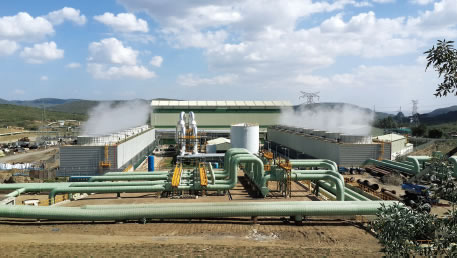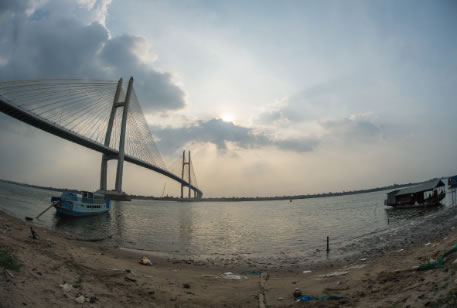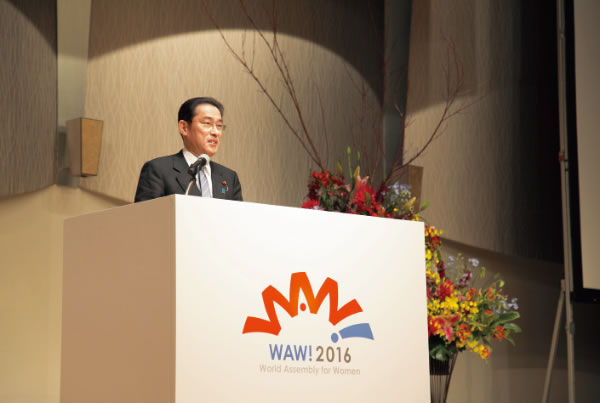Section 4 Agendas Led by Japan
•Quality infrastructure investment

Attaining the improvement of stable supply of electricity in Kenya’s Rift Valley Province through the construction of Units 4 and 5 of the Olkaria I Geothermal Power Station (70 MW × 2) (Photo: JICA)
In May 2016, Japan held the presidency at the G7 Ise-Shima Summit and the G7 Ise-Shima Principles for Promoting Quality Infrastructure Investment incorporating the basic elements of quality infrastructure investment were endorsed by the G7. The global demand-supply gap of investment in infrastructure (socio-economic foundations) has become a serious bottleneck for economic growth throughout the world and development issues the world is facing. In particular, it is said that the demand for infrastructure development in Asia is enormous, but building infrastructure itself must not be the objective. The important points are that Asia continues to drive the global economy as a growth center of the world through infrastructure development, and the fruits of the growth reach all corners of the region and society, including the socially vulnerable. The awareness that “quality infrastructure investment” is necessary for realizing the above-mentioned objective is spreading throughout the world. Clear statements about “quality infrastructure investment” are made in the 2030 Agenda and the leaders’ documents of the recent G7, G20, and ASEAN (Note 2) summits, and APEC, (Note 3) etc.

The Neak Loeung Bridge (Tsubasa Bridge) in Cambodia was opened to traffic in April 2015. The primary span is 640m with a total bridge length of 2,215m, and reaches 5,400m when including connected roads. Previously, crossing the Mekong River by ferry took one hour, but it has been reduced to approximately 5 minutes with the opening of the bridge. (Photo: Shinichi Kuno / JICA)
In infrastructure investment, it is important that while the infrastructure itself is user-friendly, safe, resilient against natural disasters and “quality”, the infrastructure project is based on the needs of the partner countries. In addition, the infrastructure development should put importance on harmonization with the local environment, communities and the lives of the people, the cost-effectiveness in the long run from construction to maintenance, and job creation and skill transfer to local areas. It is also important that coordination and dialogue from a long-term perspective are carefully carried out from the planning stage in compliance with international standards and rules. Moreover, the funding and know-how of the private sector need to be utilized. This is the big picture of “quality infrastructure investment.”
Furthermore, in advance of the G7 Ise-Shima Summit, Japan announced that it would provide financing of approximately $200 billion over the next five years across the world through the “Expanded Partnership for Quality Infrastructure.” Subsequently the basic elements of quality infrastructure investment constituting the G7 Ise-Shima Principles for promoting Quality Infrastructure Investment were also mentioned in the Nairobi Declaration adopted in TICAD VI, the G20 Hangzhou Summit Leaders’ Communique, the outcome documents of the East Asia Summit, etc., and the concept of quality infrastructure is recognized internationally. The Government of Japan will promote “quality infrastructure investment” under collaboration with countries around the world, including in Asia, and international organizations, while indicating the necessity of promotion of “quality infrastructure investment” and its specific content in various situations for the growth of the world and for the solution of development issues such as poverty, inequality, etc.
•Women
With the belief that it is essential for a vibrant and growing society to create an environment where women can demonstrate their power to the fullest extent, Japan is enhancing cooperation with the international community towards realization of “a society where women shine.” As a part of that cooperation, Japan has held the World Assembly for Women (WAW!) since 2014, inviting many leaders from overseas to appeal for a reformation of workstyles which are barriers to the promotion of women’s active participation in society and perceptions of gender norms between men and women, and in addition listening to the voices of youth and women facing difficulties, and holding comprehensive discussions on a variety of issues facing women, including disaster risk reduction, starting a business, education, peacebuilding, etc.
At the G7 Ise-Shima Summit held in May 2016 Japan, as the country holding the presidency and taking into account of the outcomes of the Elmau Summit (Germany) in 2015, took up empowerment of women including education, promoting the active role of women in the natural sciences and technology areas, etc. as one of the priority issues, and thereby increased the international momentum towards promoting the active role of women in all areas. Also, in order to put into practice the “gender mainstreaming” clearly stated in the SDGs, under the leadership of Prime Minister Abe, agenda items related to women were raised at all of the G7 ministerial meetings for the first time in history. The outcome of this was that the G7 leaders shared the perception that empowerment to realize the potential of women, promoting the active role of women in Science, Technology, Engineering, and Mathematics (STEM) areas and encouraging the participation of women in the areas of peace and security are important, and agreed to the “G7 Guiding Principles for Capacity Building of Women and Girls: Towards Sustainable, Inclusive and Equitable Growth and Peace.” Furthermore, they launched the Women’s Initiative in Developing STEM Career (WINDS) in order to increase momentum towards and foster an enabling environment for promoting the active role of women in the areas of science and technology.
Additionally, Japan took this opportunity to announce the Development Strategy for Gender Equality and Women’s Empowerment as one of the new thematic policies based on the Development Cooperation Charter, declared that it would implement the development of human resources including capacity building for approximately 5,000 female officials, etc. and improving the learning environment of approximately 50,000 girls over the three years from 2016 to 2018, and is steadily implementing these measures.
The Development Strategy for Gender Equality and Women’s Empowerment, aiming to promote the active role of women in developing countries, has designated the priority areas of (i) promoting women and girls’ rights, (ii) creating an enabling environment for women and girls to reach their full potential, and (iii) advancing women’s leadership in politics, the economy, and other public fields. Specifically, it is aiming to assist the development of an environment and building of systems that enable women to expand the options in their own lives and independently pursue their own potential freely, through infrastructure with due consideration to gender perspectives, assistance for girls’ education including in STEM fields, promotion of the participation of women in leadership roles, particularly in disaster risk reduction, etc.

Foreign Minister Fumio Kishida delivers a speech at WAW!2016, held in Tokyo in December 2016.
•Health

Infant medical check-up held at the Maternal and Child Health Center of the Chilenje Clinic in Zambia (Photo by Atsushi Shibuya / JICA)
Japan places importance on and promotes its contribution to the area of global health under the concept of “human security,” which focuses on each individual person and realizes a society in which people can live with dignity through the protection and empowerment of individuals. In particular, since the adoption of the 2030 Agenda and the establishment of the Basic Design for Peace and Health, a guideline for Global Health policy under the Development Cooperation Charter in September 2015, Japan has exercised leadership to produce outcomes including the hosting of international conferences with regard to the response to public health emergencies and the promotion of Universal Health Coverage (UHC).
At the G7 Ise-Shima Summit held in May 2016, Japan led the discussions as the country holding the presidency. The leaders highlighted health in the G7 Ise-Shima Leaders’ Declaration and agreed on the importance of three areas, which are strengthening of the capacity to respond to public health emergencies, such as infectious diseases, promotion of UHC which also contributes to crisis management and response, and reinforcement of responses to antimicrobial resistance (AMR). Concrete actions in these areas were elaborated in the G7 Ise-Shima Vision for Global Health. Furthermore, Prime Minister Abe announced that Japan decided to contribute a total of approximately $1.1 billion to international health organizations for preparedness for and prevention of public health emergencies, protection against infectious diseases, and health system strengthening aiming at the realization of UHC as Japan’s concrete contribution.

A Japan Overseas Cooperation Volunteer, Ms. Tomomi Kera, works as a midwife at the regional health division of the prefectural hospital of Punakha, the former capital city of Bhutan. She provides maternal and child health services such as consultation services for pregnant women, health checks for expecting mothers, health checks for infants, immunization, and family planning consultations. (Photo: Bhutan Broadcasting Service)
Moreover, TICAD VI held in August 2016 highlighted one of the priority areas and focused on strengthening the response to public health emergencies and promoting UHC, which also contributes to prevention and preparedness for those crises, as elaborated under one of the priority pillars “Promoting resilient health systems for quality life” in the Nairobi Declaration. Furthermore, Prime Minister Abe announced, regarding the declaration at the G7 Ise- Shima Summit, that Japan will contribute approximately $1.1 billion to international health organizations, Japan would provide assistance of more than $500 million to Africa through organizations including the Global Fund to fight AIDS, Tuberculosis and Malaria and the Gavi Vaccine Alliance to save the lives of more than 300,000 people, provide training to approximately 20,000 experts and policy officers for measures against infectious diseases, and increase the number of people who have access to the basic health services by approximately 2 million people. Also, in the high-level event on “UHC in Africa” jointly hosted by Japan and international organizations, the Global Fund and the World Bank announced they would make a contribution of $24 billion over the next three to five years to health systems in Africa. Moreover, Japan jointly announced with the World Health Organization (WHO), the World Bank, the Global Fund, and the African Development Bank the policy framework “UHC in Africa” that African countries could refer to when formulating specific national strategies towards the realization of UHC in Africa.
- Note 2: ASEAN: Association of South East Asian Nations
- Note 3: APEC: Asia-Pacific Economic Cooperation
